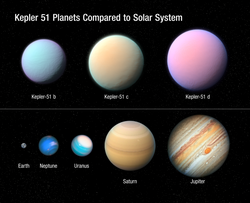Astronomy:Kepler-51
From HandWiki
(Redirected from Astronomy:Kepler-51c)
Short description: Sun-like star in the constellation Cygnus
| Observation data Equinox J2000.0]] (ICRS) | |
|---|---|
| Constellation | Cygnus |
| Right ascension | 19h 45m 55.1428629445s[1] |
| Declination | +49° 56′ 15.650520690″[1] |
| Characteristics | |
| Spectral type | G[2] |
| Astrometry | |
| Radial velocity (Rv) | −4.3[3] km/s |
| Proper motion (μ) | RA: 0.075±0.020[1] mas/yr Dec.: −7.451±0.019[1] mas/yr |
| Parallax (π) | 1.2457 ± 0.0165[1] mas |
| Distance | 2,620 ± 30 ly (800 ± 10 pc) |
| Details[4][2] | |
| Mass | 0.985±0.012 M☉ |
| Radius | 0.881±0.011 R☉ |
| Luminosity | 0.66[5] L☉ |
| Surface gravity (log g) | 4.51+0.03 −0.04 cgs |
| Temperature | 5,662+64 −65 K |
| Metallicity [Fe/H] | +0.04±0.04 dex |
| Rotational velocity (v sin i) | 5.5±1.0[3] km/s |
| Age | 500±250 Myr |
| Other designations | |
| Database references | |
| SIMBAD | data |
Kepler-51 is a Sun-like star that is about 500 million years old.[2] It is orbited by three super-puff planets—Kepler-51b, c, and d—which have the lowest known densities of any known exoplanet. The planets are similar in radius to gas giants like Jupiter, but have unusually small masses for their size, only a few times greater than Earth’s.[2]
Planetary system
| Companion (in order from star) |
Mass | Semimajor axis (AU) |
Orbital period (days) |
Eccentricity | Inclination | Radius |
|---|---|---|---|---|---|---|
| b | 3.69+1.86 −1.59 M⊕ |
0.2514±0.0097 | 45.1542±0.0003 | 0.03±0.01 | 89.78+0.15 −0.17° |
6.89±0.14 R⊕ |
| c | 4.43±0.54 M⊕ | 0.384±0.015 | 85.3139±0.0017 | 0.01+0.02 −0.01 |
— | 8.98±2.84 R⊕ |
| d | 5.70±1.12 M⊕ | 0.509±0.020 | 130.1845±0.0007 | 0.01±0.01 | 89.91+0.06 −0.08° |
9.46±0.16 R⊕ |
Kepler-51 has three planets, all super-puffs. Kepler-51b, c and d have some of the lowest known densities of any exoplanet.[2]
References
- ↑ 1.0 1.1 1.2 1.3 1.4 Brown, A. G. A. (2021). "Gaia Early Data Release 3: Summary of the contents and survey properties". Astronomy & Astrophysics 649: A1. doi:10.1051/0004-6361/202039657. Bibcode: 2021A&A...649A...1G. Gaia EDR3 record for this source at VizieR.
- ↑ 2.0 2.1 2.2 2.3 2.4 2.5 Libby-Roberts, Jessica E. et al. (2020). "The Featureless Transmission Spectra of Two Super-puff Planets". The Astronomical Journal 159 (2): 57. doi:10.3847/1538-3881/ab5d36. Bibcode: 2020AJ....159...57L.
- ↑ 3.0 3.1 Petigura, Erik A. et al. (September 2017). "The California-Kepler Survey. I. High-resolution Spectroscopy of 1305 Stars Hosting Kepler Transiting Planets". The Astronomical Journal 154 (3): 20. doi:10.3847/1538-3881/aa80de. 107. Bibcode: 2017AJ....154..107P.
- ↑ Johnson, John Asher et al. (September 2017). "The California-Kepler Survey. II. Precise Physical Properties of 2025 Kepler Planets and Their Host Stars". The Astronomical Journal 154 (3): 9. doi:10.3847/1538-3881/aa80e7. 108. Bibcode: 2017AJ....154..108J.
- ↑ Brown, A. G. A. (August 2018). "Gaia Data Release 2: Summary of the contents and survey properties". Astronomy & Astrophysics 616: A1. doi:10.1051/0004-6361/201833051. Bibcode: 2018A&A...616A...1G. Gaia DR2 record for this source at VizieR.
- ↑ "KOI-620". SIMBAD. Centre de données astronomiques de Strasbourg. http://simbad.u-strasbg.fr/simbad/sim-basic?Ident=KOI-620.
- ↑ Masuda, Kento (2014). "Very Low Density Planets Around Kepler-51 Revealed with Transit Timing Variations and an Anomaly Similar to a Planet-Planet Eclipse Event". The Astrophysical Journal 783 (1): 53. doi:10.1088/0004-637X/783/1/53. Bibcode: 2014ApJ...783...53M.
Further reading
- Kepler-51 is Home to Three Super-Puff Exoplanets, Sci-News, Dec 20, 2019 by Natali Anderson
 |


